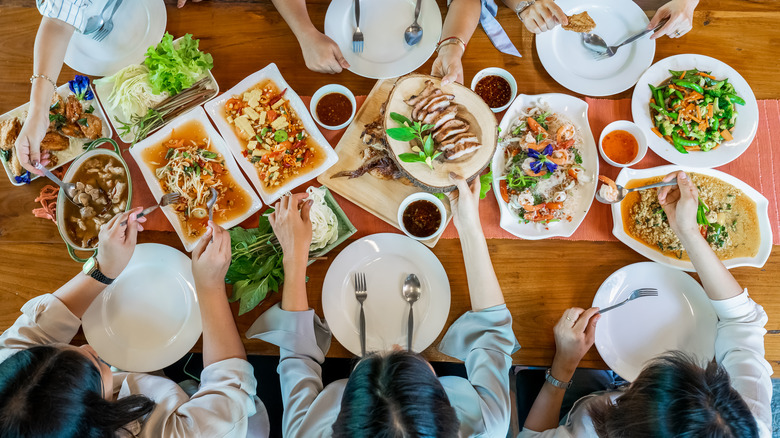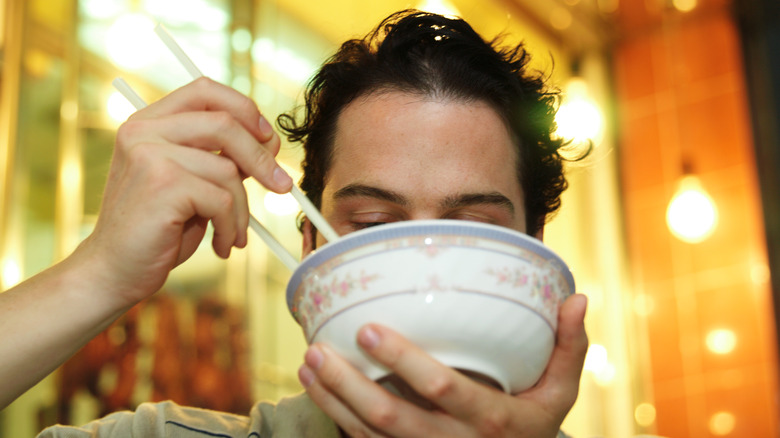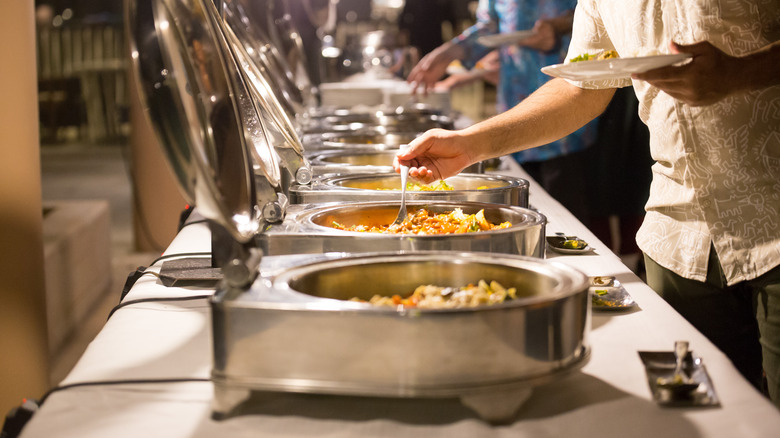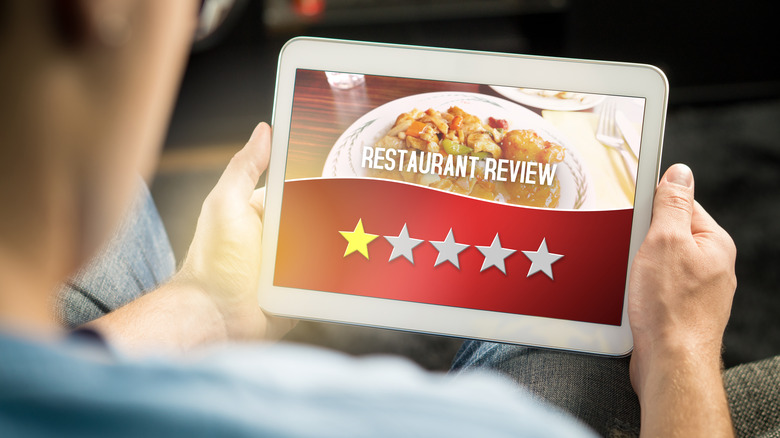12 Red Flags To Look Out For When Dining At A Thai Restaurant
If you are a fan of Thai food, you may have searched around for a good spot more than once. Still, when picking restaurants, it can be hard to discern the good from the bad, especially when it comes to specific cuisines. So, what constitutes a quality Thai restaurant? Taste is obviously essential.
In "Anthony Bourdain Parts Unknown," Bourdain described this cuisine as "a world of fresh, delicious, spicy, meaty, salty, sour, sweet, bitter. Often with a just-picked herby dimension." When you leave a new Thai joint, you know immediately whether it fits this bill. But flavor isn't the only thing to consider. Your overall experience is impacted by the service, ambiance, and — to put it lightly — the after-effects. Poor cooking methods or hygiene practices could leave you deeply regretting your visit.
But is there a way to avoid the pitfalls of a subpar Thai restaurant? The short answer is yes. Both chefs and restaurant-goers would agree that there are some clear warning signs to look out for. So if you're dining at a Thai restaurant soon, keep an eye out for these red flags.
1. Chopsticks
Are you accustomed to seeing chopsticks at your favorite Thai place? This isn't necessarily a red flag but more an indication of an American-style Thai restaurant. In an interview with Insider, celebrity chef Jet Tila said, "If a Thai restaurant sets with a spoon and a fork, that's gonna tell me that they're slightly more authentic because the proper way to eat Thai food, you know, with Jasmine rice, is fork and spoon."
Imagine eating green curry with chopsticks. You'd miss out on all the creamy coconut and spices of the broth. A spoon is the most practical way to eat this dish. And knives are rarely needed for Thai food because most everything comes in bite-size form. However, there are some key exceptions, like noodles or soup. If you've ordered pad Thai or pad see ew, expect chopsticks to be delivered to your table. Soups like khao soi are served with chopsticks and an Asian soup spoon. But unless it's a noodle house, traditional Thai restaurants will generally wait to add these utensils to your place setting.
So, if your table is set with a fork and spoon, consider this a green flag. And if you see chopsticks, there's no need to walk out — the food may still be incredible. The restaurant might serve many noodle dishes and simply be thinking ahead. Or, it may cater to a Western clientele who have grown accustomed to seeing chopsticks at all Asian eateries.
2. Nothing Is Spicy
While not all Thai food is spicy, it has a reputation for a reason. Thai cuisine uses many spices, including bird's eye chili, whose spiciness ranges from 50,000 to 100,000 on the Scoville scale. To put this in perspective, your average jalapeño rings in at 5,000 Scoville units. The bird's eye chili is more extreme, but typical Thai food also utilizes black pepper, ginger, and garlic, all contributing to that warming sensation. So if you're ordering a wide variety of Thai foods and feeling nothing, it's suspicious.
So which Thai meals burn and which are on the safe side? Most noodle dishes like pad Thai or pad see ew are mild, while other plates provide a serious slap-in-your-face spice. One of these dishes is southern Thailand's gaeng tai pla, a fiery curry made of fermented fish innards. Although this curry packs a punch, it's a common misconception that all curries do so. Thai yellow curry is mild, red curry is medium-hot, and green curry is the spiciest of the bunch.
Many Thai menus in the States will come with a spice indicator, or your server will ask you how spicy you'd like your meal. Typically, the spice scale ranges from one to five, with one being minimal and five being almost unbearable. So, if your server warns you that a meal could be too painful to persevere, consider it a warning, not a challenge. But if a Thai restaurant has no spice at all, consider it a giant red flag.
3. Peanut Sauce Is Everywhere
If you love the peanut sauce that comes with some Thai dishes, you're not alone. But you might be surprised to learn it's not entirely Thai. Peanut sauce, as we know it, is something Americans have slightly commandeered. Three Thai dishes known for this deliciously nutty sauce are chicken satay, cubed tofu, and tod mun sauce. In the U.S., the peanut sauce will be a rich, viscous liquid perfect for dipping or mixing into stir-fries. But in Thailand, you'll often find ground peanuts sprinkled atop dishes instead.
While peanut sauce in Thai food isn't entirely authentic, it's not a red flag on its own. There's nothing wrong with adapting cuisines to suit people's tastebuds, and chicken satay is a top seller on many Thai menus. But there's a time and place for this sauce. If you notice peanut sauce popping up where it doesn't belong, like an unwanted dinner guest, something's off. And it's not a taste that goes unnoticed, either. The usual pad Thai will have a sprinkling of ground nuts, but if you're tasting an overwhelming peanut flavor, the chef has gone nuts with the sauce.
4. The Menu Is Huge
If a restaurant is a jack of all trades, it's a master of none. Although a huge menu caters to a large audience, it's hard for the kitchen and waitstaff to juggle such a wide array of dishes. The flavor, consistency, and quality can take a hit. Some restaurants manage to pull it off, but generally speaking, it's a red flag. Conversely, shorter menus mean kitchen staff can hone their skills and perfect each recipe.
Having a long list of ingredients also means dishes probably aren't fresh. When restaurants cook everything from curry to lasagna to french fries, it's unlikely that they make everything on the spot. Chances are kitchen staff are cooking with frozen, reheated, or premade products. Not only does this compromise quality, but it can also lead to food safety issues.
When it comes to cooking, the U.S. Department of Agriculture refers to the "danger zone" as the temperature range of 40 degrees Fahrenheit to 140 degrees Fahrenheit — where bacteria can multiply at a dangerous rate. As such, Mayo Clinic states that it's safe to leave food out for about two hours at room temperature, but the time frame decreases as the temperature increases. Kitchens are known to be hot, so let's hope they take extra precautions to store food safely. But even when properly stored, reheated foods just don't taste the same.
5. The Menu Includes Other Cuisines
Having an extensive menu is a red flag. But having one that is too diverse, or strays from real Thai cuisine, could also be a bad sign. As a rule of thumb, avoid Thai menu items that seem wildly out of place. Asian fusion is one thing — and it can be done really well. But we're not talking about blending two cuisines into a new culinary creation. We're referring to throwing one or two international dishes on an otherwise Thai menu.
If you were to see spaghetti on the list, you'd immediately think it was odd. The same should go for sushi or chow mein. These are entirely different Asian cuisines. While Thai food pulls influences from other regions, adding an entire section of foreign-based dishes can confuse kitchen staff and customers. Different cuisines require different cooking methods, and forcing kitchen staff to learn and switch between several types compromises quality.
Dan Coughlin, a chef who grew up in his Thai mother's kitchen, explained on Eat This, Not That why this might be: "Any Thai restaurant that still has Chinese dishes on the menu, avoid. There are some that still do that because they think they have to. My mom told me when she had a restaurant in the '80s, no one knew what Thai food was, so you had to put a kung pao or orange chicken on the menu to get people in the door."
6. It's A Thai Buffet
There are many red flags at buffets, and Thai buffets aren't super common in the States for good reason. Buffets require food to sit out for extended periods. But doing so would inevitably kill the freshness and aromatic flavors that people have come to love in Thai cuisine.
Plus, the high-quality ingredients in Thai food don't lend themselves well to an all-you-can-eat setting. Spices or herbs that can't be found in the States are imported, increasing the overall price tag of dishes. Thai cuisine also uses many seafood products like shrimp, which is quite costly stateside. All things considered, a Thai buffet often translates to lower-quality food and higher prices — not exactly a winning combo.
If you're looking for quality Thai food but want to try many dishes — or cut down on costs — eat it family-style. Many dishes are meant to be shared, so you can eat more than one without sacrificing freshness or flavor. Why not have your Thai cake and eat it too?
7. There Is A Lack of Thai Decor
Any restaurant should reflect the type of food it serves. In many well-rated Thai restaurants, the Thai element shines through. They don't just look like your average diner or same-looking fast food restaurants. Instead, traditional aspects of Thai culture are expressed through artwork, photography, or interior design.
You might notice elements of the culture in the architecture or even the table settings. These little touches might be subtle, but they reaffirm our idea that the Thai food is authentic. Culture and food are closely intertwined in Thai restaurants, partially because many are owned by Thai Americans. One reason for this is due to the Thai government's efforts at gastro-diplomacy.
In an interview with the Splendid Table, Mark Padoongpatt, Asian Studies professor at the University of Las Vegas Nevada, explains that the Thai government "[trains] chefs and [exports] them everywhere around the world to open and work in restaurants. It's to stimulate tourism to Thailand, but it's also an effort to standardize Thai taste around the world because the government feels like the different kinds of Thai food around the world has given it somewhat of a bad name."
If this is the case at your local Thai restaurant, the owners would likely promote Thai culture through decor along with cuisine. And while aesthetics aren't necessary to create incredible food, they do contribute to the overall dining experience.
8. The Bathrooms Are Dirty
Dirty bathrooms are a dead giveaway that hygiene is being neglected. It's the out-of-sight, out-of-mind mentality. If the front of the house appears clean, but the bathrooms are not, it might just be a facade. This gets us thinking, if the bathrooms aren't well-kept, what other shortcuts are the cleaning staff taking?
A dirty bathroom equals a dirty restaurant. But even if the kitchen was spick and span, an unkept bathroom alone can lead to food poisoning. One 2019 study published in The Lancet found that most superbug infections linked to E. coli were not from food sources but transferred via the fecal-oral route. If you're not already cringing in disgust, let's explore how this can happen. Even if the cooking staff wash their hands properly, they still turn off the faucet and open the bathroom door.
If these surfaces aren't properly disinfected, those germs can be transferred down the line, ultimately ending up in your food or dishware. The same goes for clientele. This red flag isn't exclusive to Thai restaurants but should be applied to all eating establishments. So pay attention to the dirty details, and if you're grossed out on your bathroom break, reconsider the restaurant.
9. There's An Odd Smell
If something smells fishy, it's not a good sign. Even if the restaurant serves Thai seafood favorites like seafood tom yum or crispy catfish salad, it should never smell overwhelming. Many people assume fish should have a powerful aroma, but this isn't the case. Fresh seafood is reminiscent of salt water or the ocean, but when it takes on an overly fishy odor, it's starting to go off.
But fishiness isn't the only thing you should look out for. If you pick up on a sour stench, something might be rancid. And if you notice a strong disinfectant smell upon entering, you can't help but wonder: What are they covering up? With the strong connection between our olfactory senses and taste buds, a bad smell can have a massive impact on a meal. So whether an off-putting odor is a health concern or merely an inconvenience, it doesn't bode well for your dining experience.
10. The Restaurant Is Constantly Under New Management
There are a few reasons why a restaurant would put up an "under new management" sign, but they almost always point to the same thing. Ultimately, owners or management believe they can do better moving forward, and they want people to know. Which begs the question: What was wrong in the first place?
It could be anything from poor management, accounting, or food quality. Best-case scenario, the old managers are successfully retiring, and new ones are happily taking over. But in many cases, putting up such a sign feels like admitting defeat and hoping for a fresh start.
At times, it's obvious that a place is looking to change its reputation and bring in more customers. Whether or not the tactic works is up for debate, but it's bound to raise some eyebrows in the process. And if management is constantly hanging that banner, it gives the impression the restaurant just can't get it together.
In a business, there's a time to hold them and a time to fold them. If a restaurant needs a complete upheaval, new management might be the right move. And hopefully, the optimistic sign reflects real change behind those doors. However, with any change comes uncertainty and a period of readjustment. A learning curve might result in slow service or ill-equipped kitchen staff. If your local Thai restaurant is due for an upgrade, give it another try. But if that banner keeps reappearing, consider going somewhere else.
11. Servers Don't Know The Menu
You'll get the occasional new server, but well-trained crew members know the menu and have found a few of their favorites. If that's not the case, the server might be unreliable, or something is off in the chain of command. Management may be cutting corners on training, or turnover is too high to keep up.
Regardless of the reason, it's never a good sign if your server doesn't know the menu. For one, they won't be able to answer questions about flavors, ingredients, or how spicy those Thai dishes are. For those with dietary restrictions, a server's lack of knowledge can make ordering a bit nerve-racking.
If waitstaff can't answer questions, they'll run to the back — and thus begins a game of telephone, which, as we know, is typically riddled with miscommunications. Guests often ask for waitstaff recommendations. What are their favorite dishes? Which ones are spicy versus mild? And what do they think of tonight's special? If your server hasn't tried the food, it's hard to trust their opinion. And if they don't know the menu at all, you are fully on your own.
12. There Are Many Bad Reviews
Reviews speak for themselves and are a good indication of what to expect from most restaurants — Thai places included. However, you should take them with a grain — or a bucket — of salt. Some reviewers like an audience to boost their ego or show off knowledge, while others genuinely try to help.
Many people love a good rant, especially when they feel they have been wronged. And unfortunately, it is human nature to have a bias. According to a 2013 study by Zendesk on Rize Reviews, people are more inclined to leave negative customer experiences than positive ones. As a result, the ratio of positive to negative comments doesn't always reflect the restaurant's overall service.
So, when can you trust a review? Some customer reviews are spot on and can prove helpful when deciding where to eat. Look for objectivity in their voice. People writing in the heat of the moment might be seeing red, even if they have valid concerns; it can sometimes skew an entire experience.
A more natural stance shows that the customer can view things clearly and is coming from a more genuine place. You should also look for patterns. Some comments are one-offs, but it's probably not a coincidence if you notice a string of poor reviews with the same complaints. If you start seeing the same negative comment reappear, it might be telling of something worth avoiding. The same goes for positive reviews and something worth trying.












